| Orienti oriens |
音楽エッセイのページへ戻る
St.マーシャル楽派へ
Jubilemus, exultemusの解説ページ(英語)へ
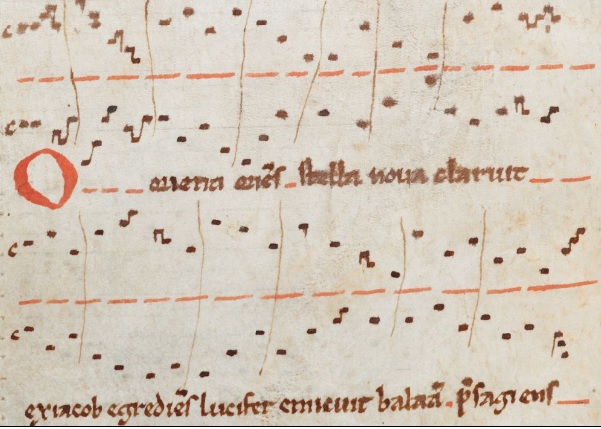 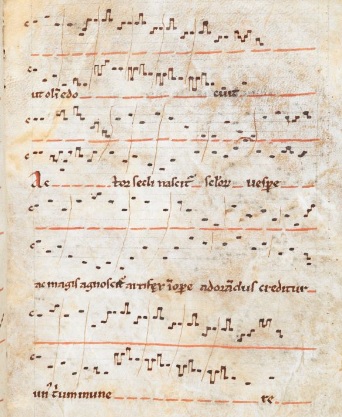 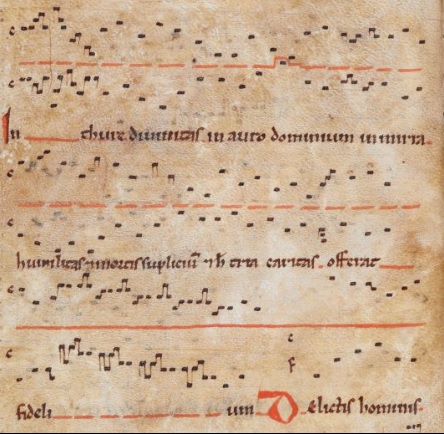 Add MS 36881 17v なお、この曲はMSS3719にも収められているが、そちらの譜には縦線が入っていない。こちらの譜でも、最後のstanza(In thure〜)には縦線がないために、この部分だけはソースが別なのではないか、と言われているらしい。 この曲に関しては、以下のサイトに非常に細密な解説があります。 Relationships between the Twelfth-Century Aquitanian Polyphonic Versus and Two-Part Conductus Repertories 5.3.1 Texted Section of Orienti oriens The texted section of Orienti oriens uses intervals from the Organum Interval Group. The work appears to have been composed as a two-part piece rather than by adding an upper voice to a pre-existing melody. The way that the voices work together to create phrases of contrary motion and series of consonant intervals suggests that the choice of intervals was more important in the work's composition than individual melodic lines.21 The very strongly syllabic texture of the textedsection is set with primarily highly consonant intervals, as is typical of the intervals used in the note-against-note style in the works in D-II and other later manuscripts. The most commonly used intervals in the texted section of this work are the sixteen unisons and the eleven fifths, none of which are passing intervals. Three octaves appear in the texted section, as well as a very small number of seconds, thirds, sixths and sevenths. The only other interval of significance is the fourth. Fuller observes that the fourth is not mentioned in the Discantus positio vulgaris as one of the better choices of consonant intervals. Fuller also notes that while the Vatican Organum Treatise includes the fourth as one of the primary consonances to be used in organum, it does not include the fourth as a primary consonance in any of its 343 musical examples.23 There are eight fourths used in Orienti oriens, and none of these are passing intervals. The way that these fourths are used is a particular feature of this work. Where the D-II version repeats the syllable "o" at the start of the word "orienti," we may see a particular pattern of intervals.unison, fourth, unison.that reappears as an intervallic motif later in the work (see Example 5.1 below). At the beginning of line 3 of the text, set to the words "et jacob," the motif repeats exactly the pitches used in line 1. When the motif appears again at the start of line 5 with the text "balaam," the pitches have been swapped between the voices, and the pattern of the intervals has been extended to form sequential patterns in the voices, creating the progression 1-4-1-4-1. The motif's last appearance is at the start of line 6 (Example 5.1 shows the text "offerat fideli-" from stanza III). Although the voices have swapped their parts back again, the motif has been transposed down a step, now beginning on c' instead of the usual d'. This use of the fourth, appearing between two unisons to begin four of the six phrases of the texted section, gives the interval particular emphasis in this work. Another significant place in which a fourth appears is at the conclusion of line 3 in each strophe of the D-II version, although the C-IV version has a pair of repeating parallel fifths instead in this position. Example 5.1. Orienti oriens, four appearances of the 1-4-1 motif in the D-II version (transcription after van der Werf, Oldest Music, vol. 2, 96-98). 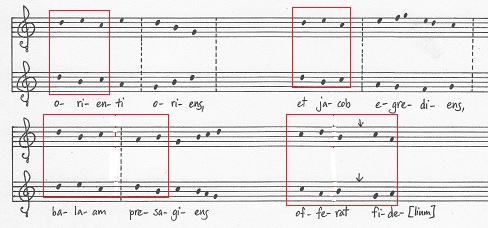 The prominent use of unisons and fifths, and the very small number of thirds, show that this work shares the same use of important intervals as the conductus that belong in the Organum Interval Group. The way that vertical lines are used is a significant difference between the two versions of this work. There are no vertical lines at all in the C-IV version of Orienti oriens; however they are very frequently used in the first and second stanzas of the D-II version. In the texted section, the vertical lines are not always in the same places. Although they are consistently used at the end of each line of text, within the lines of text the vertical lines divide the work into words, with small words such as "ac," "et" or "in" being grouped with the following word. As the lengths of the words vary, so too does the placement of the vertical lines. The third stanza in D-II does not have any vertical lines; however by observing the placement of the lines in stanzas I and II, it would not be difficult to determine where they might be placed in stanza III. Some of these would be in different places from those in the other two stanzas. If the meaning and structure of the text plays a part in determining the rhythm and phrasing of the work, then the placement of the vertical lines is significant. The difference in location of the vertical lines in stanzas I and II indicates that the rhythm of each of the three stanzas would be, perhaps subtly, different. This different approach to each stanza and the way in which it would be interpreted in performance may be reason enough for the scribe to have gone to the trouble of writing the strophe out entirely three times, although we might wonder why then the third stanza has no vertical lines, since they served so important a purpose elsewhere.24 These vertical lines appear also in the works of the conductus repertory, and will be discussed later in this chapter in relation to the conductus Debet se circumspicere. p152 5.3.1 Texted Section of Orienti oriens Orienti oriensのテキストセクションでは、Organum Interval Groupの音程を使用しています。作品は、既存のメロディーにアッパーボイスを加えるのではなく、2声部作品として作曲されている。 声部が一緒になって反対の動きのフレーズと一連の協和音の音程を作成する方法は、音程の選択が個々の旋律線よりも作品の作曲において重要であったことを示唆している21。 p153 テキストセクションの非常に強いシラビックテクスチャは、D-IIや他の後の写本の作品で note-against-note style で使用される音程の典型であるように、主に非常に協和音的音程で設定されている。22。 この作品のテキストセクションで最も一般的に使用される音程は、16のユニゾンと11の五度で、どれも経過音程を持たない。テキストセクションには3箇所のオクターブが示されるだけで、二度、三度、六度、七度も非常に少数である。他の重要な音程は四度だけとなる。 Fullerは、Discantus positio vulgarisでは、協和音音程のより良い選択の1つとして、四度が言及されていないことを考察している。フラーはまた、Vatican Organum Treatiseには、オルガヌムで使用される主要な協和音の1つとして四度が含まれているが、343の音楽例のいずれにも主要な協和音として四度は含まれていない、と記している23。Orienti oriensでは8箇所で四度が使用されており、これらはいずれも経過音程ではない。 これらの四度の使用方法は、この作品の特別な特徴である。 D-IIバージョンが「orienti」という単語の先頭で音節「o」を繰り返し、作品の後半で音程モチーフとして再表示される音程の特定のパターン(ユニゾン−四度−ユニゾン)が表示される(Example 5.1.を参照)。 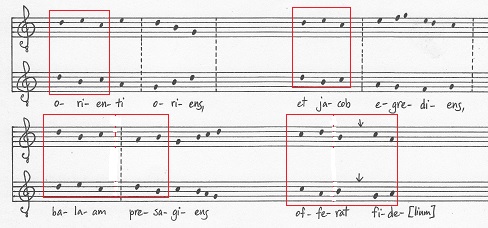 Example 5.1. Orienti oriens, four appearances of the 1-4-1 motif in the D-II version (transcription after van der Werf, Oldest Music, vol. 2, 96-98). 「et jacob」という単語に設定されたテキストの3行目の先頭で、モチーフは1行目で使用されたピッチを正確に繰り返す。モチーフが5行目の先頭に「balaam」というテキストで再び表示されると、ピッチが声部間で交換され、音程のパターンが拡張されて声に連続したパターンが形成され、進行1-4-1-4-1が作成されている。 モチーフの最後の外観は6行目の先頭にある(例5.1は、スタンザIIIの「offeratfideli-」というテキストを示している)。声部交換するが、モチーフはステップダウンされ、通常のd 'ではなくc'から始まっている。 テキストセクションの6つのフレーズのうちの4つを開始するための2つのユニゾンの間に現れる四度のこうした使用は、この作品で音程を特に強調している。 四度が現れるもう1つの重要な場所は、D-IIバージョンの各ストローフィの3行目の終わりであるが、C-IVバージョンでは、代わりにこの位置に平行五度が現れる。 p154 ユニゾンと五度の顕著な使用、および三度のごく少数は、この作品がOrganum Interval Groupに属するconductusと同じ重要な音程の使用を共有していることを示している。 縦線の使い方では、この作品の2つのバージョンには大きな違いがある。 Orienti oriensのC-IVバージョン(3719)には垂直線はまったくないが、D-IIバージョン(36881)の第1スタンザと第2スタンザでは非常に頻繁に使用されている。 テキスト化セクションでは、垂直線が常に同じ場所にあるとは限らない。これらはテキストの各行の終わりで一貫して使用されているが、テキストの行内では、垂直線が作品を単語に分割し、「ac」、「et」、「in」などの小さな単語が次の単語とグループ化されている。単語の長さが変わると、垂直線の配置も変わる。 D-II(36881)の第3スタンザ(In thure〜)には垂直線がない。ただし、スタンザIおよびIIの線の配置を観察することにより、スタンザIIIのどこに線を配置できるかを判断することは難しくはない。これらのいくつかは、他の2つのスタンザとは異なる場所にある。 テキストの意味と構造が作品のリズムとフレージングを決定する上で役割を果たす場合、垂直線の配置は重要である。 スタンザIとIIの垂直線の位置の違いは、3つのスタンザのそれぞれのリズムがおそらく微妙に異なることを示している。 なぜ第3スタンザに垂直線がないのか不思議に思われるかもしれないが、各スタンザへのこの異なるアプローチとそれが実践で解釈されたやり方は、ストローフィを完全に3回書き出すのに苦労したスクライブに対しての十分な理由となるだろう。それらは、他の場所で非常に重要な目的を果たしたからである24。 24おそらく、縦線は模範例では使用されておらず、この作品を演奏した誰かの指示の下で加えられただけのものだった。口頭伝承の一部としてそれを学び、音楽の伝達としてそれらを認識することは、記譜された形としての特殊性を持つようになった。何が重要であるかを決めるこうしたやり方が、書き留められることになったのだろう。 p155 これらの縦線は、conductusレパートリーの作品にも示され、この章の後半で、conductus Debet se circumspicereに関連して説明される。 http://www.bl.uk/manuscripts/FullDisplay.aspx?ref=Add_MS_36881 http://gallica.bnf.fr/ark:/12148/btv1b52502489w/f163.item.zoom |